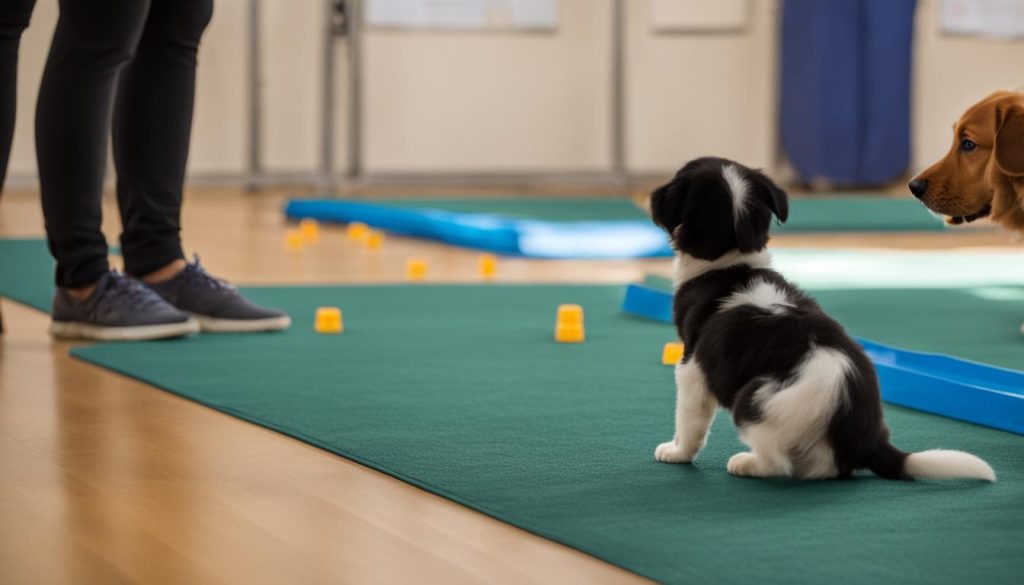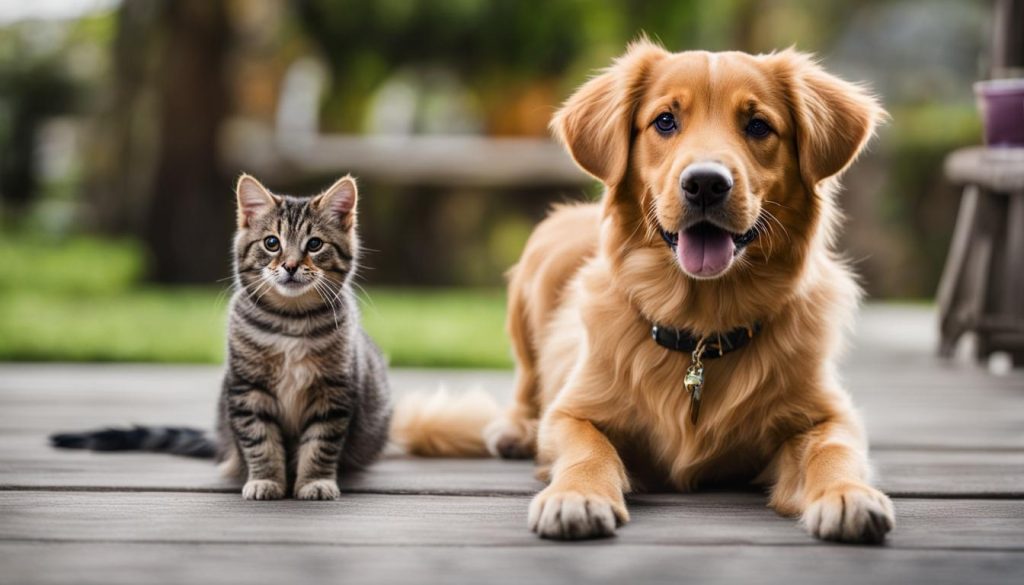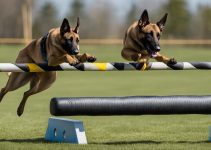Watching a puppy and a kitten grow up together contributes to natural compatibility and harmonious pet coexistence. I understand, however, that sometimes a dog’s innate urge to chase can result in conflicts with a cat. How to stop puppies chasing cats is a question that troubles many pet owners, especially those who have herding breeds or terriers. In this guide, I will provide insight into the origins of dog chase behavior and share some effective strategies to teach your puppy to live peacefully with cats, even if it means using a basket muzzle in severe cases.
How to Stop Puppies Chasing Cats
- Some breeds of dogs, like herding breeds and terriers, show a strong inclination to chase.
- Puppy chase behavior can be managed and trained for peaceful coexistence with cats.
- Proper introductions and early socialization are vital for successful puppy and cat living together.
- Positive reinforcement training methods play a significant role in preventing puppies from chasing cats.
- The cookie-cat technique conditions puppies to associate the cat’s presence with rewards, diminishing the desire to chase.
- Environmental management can ensure safety and prevent puppy-cat conflicts.
- Patience, consistency, and dedication are essential for maintaining harmonious pet relationships.
Understanding the Canine Urge to Chase
Chasing behavior is deeply rooted in a dog’s canine predatory instinct. This natural urge to chase typically emerges in response to rapid movements, especially those of a fleeing cat. Different dog breeds exhibit varying levels of chase drive due to their unique breeding purposes. For instance, herding breeds and terriers are known to have a particularly strong propensity for chasing behavior. Recognizing and understanding this innate drive is crucial for effectively managing and training puppies to resist the temptation of chasing cats, ultimately fostering a peaceful coexistence within the household.
In order to prevent any dangerous or harmful situations in a multi-pet household, it is essential to identify the triggers of the dog’s chase behavior. A common catalyst for triggering a dog’s chase response is a cat sprinting away, as it activates the dog’s predatory instincts. To avoid activating these instincts, it is important to minimize the opportunities for a sudden escape by the cat near the puppy.
Familiarizing oneself with the characteristics of different breeds can be highly beneficial in understanding and managing a dog’s chase drive. As previously mentioned, herding breeds and terriers are more likely to exhibit chasing behavior, primarily due to their breeding history. Herding dogs, such as Border Collies and Australian Shepherds, were bred for their ability to control and direct the movement of livestock. Similarly, terrier breeds, including Jack Russell Terriers and Rat Terriers, were developed for their exceptional capacity to chase and catch vermin. Knowing the unique traits of these breeds allows for more targeted and efficient training techniques to curb their chase tendencies.
By understanding the origins and motivations behind a dog’s chasing behavior, pet owners can be better equipped to address and manage this often problematic instinct in their puppies. A comprehensive knowledge of the canine predatory instinct and the specific proclivities of herding breeds and terriers provides a solid foundation for effectively training puppies and ultimately achieving a harmonious coexistence between dogs and cats in the home.
Step 1: Introducing Puppies and Cats the Right Way
Proper introductions between puppies and cats are essential for establishing harmonious relationships. By focusing on early socialization, you can significantly decrease the likelihood of chase behavior. This can be achieved by keeping the cat stationary, for example, in a carrier, while introducing a leashed puppy.
Puppy and Cat Introduction Tips
When introducing your puppy to a cat for the first time, consider following these tips to ensure a positive interaction:
- Keep the cat in a carrier or safe space to prevent sudden movements that might trigger the puppy’s chase instincts
- Ensure the puppy is leashed and under your control
- Maintain a calm atmosphere to avoid triggering stress responses in either pet
- Offer treats to the puppy when they remain calm and obedient, reinforcing positive behavior around the cat
- Allow gradual, supervised interactions until the puppy and cat become familiar with each other’s presence
Managing Puppy-Cat Interactions for Positive Outcomes
Ongoing management and structured interactions are essential for reinforcing respectful boundaries between your puppy and cat. Employing reward-based strategies, such as offering treats to the puppy for calm behavior around the cat, can be very effective. Additionally, implementing a leash during training periods is recommended, as it restrains any spontaneous chase attempts by the puppy and helps to redirect their attention towards you for rewards.
Maintaining proper pet introductions and managing puppy-cat interactions through positive reinforcement training methods are crucial aspects of preventing your puppy from chasing the cat. By fostering a calm environment during initial meetings and continuously rewarding positive behaviors, both animals can learn to adapt and coexist peacefully.
Step 2: Training Strategies to Curtail the Chase
Training puppies to resist their chase impulses towards cats involves consistent and positive reinforcement. The focus should be on rewarding desired behaviors, such as ignoring the cat or obeying commands, rather than punishing undesirable actions. Effective training strategies for dogs include keeping the puppy leashed during initial interactions, controlling their environment to prevent chases, and using commands coupled with rewards to teach alternative, acceptable behaviors.

One method for stopping chase behavior is known as the “sit-stay” technique. Begin by teaching your puppy the “sit” and “stay” commands, making sure they are proficient in each. Once your puppy has mastered these commands, you can start integrating the cat into your training sessions. With your puppy on a leash, ask them to sit and stay while allowing the cat to be in their view. If your puppy maintains their position and does not try to chase the cat, reward them with a treat and praise. Over time, this will help your puppy develop impulse control and curtail puppy chasing tendencies.
Another useful training strategy is teaching your puppy the “leave it” command. This command is particularly helpful in redirecting your puppy’s attention away from stimuli that can trigger chase behavior, such as a cat walking across the room. When your puppy starts focusing on the cat, use the “leave it” command to break their focus. Once they turn their attention back to you and away from the cat, reward them with a treat and praise. Consistently practicing this command will help your puppy learn that leaving the cat alone results in positive reinforcement.
Finally, providing your puppy with alternative outlets for their chase instincts can help diminish their desire to pursue your cat. Engaging your puppy in activities such as fetch, tug-of-war, and agility training can redirect their energy and chase impulses to more appropriate pursuits. By offering your puppy plenty of opportunities for mentally stimulating and physically exhausting playtime, you help to reduce the likelihood of them engaging in chasing behavior towards your cat.
Utilizing effective training strategies for dogs, such as consistently rewarding acceptable behaviors and providing alternative outlets for their chase instincts, will help curtail puppy chasing of cats. By investing time and effort into these training techniques, you can create a harmonious environment where both your puppy and cat can coexist peacefully.
Step 3: The Reward System -Teaching Puppies Calm Behavior Around Cats
Utilizing a reward system for puppies is an effective way of teaching them not to chase cats. In practice, it involves reinforcing positive behavior when a puppy is calm and obedient in the presence of its feline sibling. One popular technique to encourage harmonious behavior and curb chase instincts is the cookie-cat technique.

Cookie-Cat Technique: Conditioning Positive Responses
The cookie-cat technique has been found effective in training puppies not to chase cats. It involves giving treats to the dog every time it sees the cat, conditioning the dog to associate the cat’s presence with positive rewards. This reinforces the idea that a calm response to the cat results in a favorable outcome for the puppy
Over time, the puppy learns that seeing the cat results in rewards from the owner, thereby diminishing the desire to chase. The use of a clicker for clicker-training alongside treat reinforcement can further enhance this conditioning process, establishing calm behavior as the norm around cats.
With persistence, patience, and consistency in applying this reward system, owners are more likely to see improvements in their puppy’s behavior and overall interactions with cats, reducing the occurrence of unwanted chase instances and promoting a peaceful coexistence among your pets.
Step 4: Dealing with Puppy Aggression and Overexcitement
Puppy aggression and overexcitement can manifest in dangerous chasing behaviors towards resident cats. Addressing these issues requires a combination of redirection training and calming techniques. Intervening immediately with a distraction or command when chasing attempts occur teaches the puppy that such behavior is unacceptable. Employing strategies like muzzles in the short-term and reinforcement of calm behavior through treats and praise can help in situations where heightened excitement is directed towards the cat.
Dealing with aggressive puppies and their propensity to chase cats may seem daunting, but taking a measured approach can be effective. Begin by recognizing the signs of overexcitement and aggression, such as growling, snapping, or lunging. Remember to seek professional help if you’re unsure of your puppy’s behavior or need advice on training methods.
One vital tip for stopping puppies from chasing cats is to create a calm and controlled environment that discourages overexcitement. This can be achieved by providing regular exercise, mental stimulation, and establishing a daily routine that includes time for play, obedience training, and relaxation.
If your puppy exhibits concerning behavior or has a high chase drive, don’t hesitate to consult a trained professional who can offer personalized advice and guidance. They may recommend specific strategies for dealing with aggression, such as desensitization and counter-conditioning protocols, which help the puppy build positive associations with the cat’s presence.
Puppy aggression and overexcitement are challenges many pet owners face when attempting to foster a harmonious relationship between their dogs and cats. However, with patience, persistence, and adherence to the tips provided, your puppy and cat can coexist peacefully.
Step 5: Creating a Safe Environment for Both Your Pets
Ensuring a harmonious pet coexistence between your puppy and cat involves creating a safe environment for pets. This process includes setting up safety zones and providing escape routes for your cat, so they can feel secure and have space to retreat when necessary.
Setting up Safety Zones and Providing Escape Routes for Cats
To establish safety zones for cats, you can create specific areas in your home that are barricaded with baby gates or equipped with cat trees and perches beyond the puppy’s reach. This enables your cat to have a designated escape route if the puppy exhibits chase behavior. Additionally, it signals to the puppy that these areas are off-limits, further promoting a peaceful coexistence between the two animals.
Environmental Management to Prevent Puppy-Cat Conflicts
Proactively managing your pets’ environment is crucial in preventing puppy-cat conflicts. Effective environmental management for pets involves utilizing crates and carriers to control each animal’s access to one another and designating separate areas for feeding and playing. By ensuring that both pets have their own spaces, you can reduce the likelihood of conflicts arising due to territorial disputes or competition for resources.
Another key element of environmental management involves training your puppy to focus on you and using controlled lead lengths when necessary. This helps to establish a secure environment that prevents the puppy from pursuing the cat, as their attention is consistently redirected towards their owner.
Ultimately, creating a safe environment for your pets requires a combination of proactive measures and ongoing management. By implementing safety zones, escape routes, and effective environmental management strategies, you can lay the foundation for a harmonious and conflict-free relationship between your pets.
READ: Effective Positive Reinforcement with Dogs: Your Ultimate Guide
Conclusion
Creating harmonious pet relationships and preventing puppies from chasing cats is possible through careful planning, training, and environmental adjustments. By understanding the innate motivations of your puppy’s chase behavior, you can approach training with an informed perspective, ensuring a more effective process. Proper introductions, reinforcing positive behaviors, and implementing precautions to ensure the cat’s safety are instrumental in promoting peaceful coexistence between your pets.
Consistency and patience are critical for fostering the desired behaviors in your puppy. The longer you commit to training and reinforcing positive habits, the more likely your puppy will adapt to a harmonious life with your cat. Remember that, as with humans, every dog is unique, and finding the right approach for your puppy could take some time. Remain patient, consistent, and flexible while evaluating and adjusting the strategies you employ.
By dedicating your attention to understanding your pets and employing the proper techniques, you can create a safe, content, and harmonious home for both your puppy and your cat. Though it may take time, effort, and adjustment, the resulting bond between your pets will be an immensely rewarding experience for you and your entire household.
FAQ
What triggers the canine urge to chase?
Dogs have an innate drive to chase, which stems from their inborn predatory instincts. Rapid movements, particularly those of a fleeing cat, can trigger a dog’s chase response. Different breeds have varying levels of chase drive; herding breeds and terriers, due to their specific breeding purposes, show stronger propensities for chasing behavior.
How can I introduce a puppy and cat the right way?
Proper introduction between puppies and cats is essential for a harmonious relationship. Early socialization significantly decreases the likelihood of chase behavior. Keep the cat stationary, for example in a carrier, while introducing a leashed puppy. Provide continuous positive reinforcement, such as offering treats when the puppy remains calm and obedient, to establish respectful boundaries between the two pets.
What training strategies can I implement to curtail my puppy’s chasing behavior?
Training puppies to resist their chase impulses towards cats involves consistent and positive reinforcement. You can try keeping the puppy leashed during initial interactions, controlling their environment to prevent chases, and using commands coupled with rewards to teach alternative, acceptable behaviors.
How can I use the reward system to teach my puppy calm behavior around cats?
The cookie-cat technique is an effective way to teach calm behavior around cats using a reward system. Give your puppy treats every time it sees the cat to create a positive association with the cat’s presence. You can enhance this conditioning process by using a clicker for clicker-training alongside treat reinforcement, establishing calm behavior as the norm around cats.
How can I deal with puppy aggression and overexcitement directed towards cats?
Addressing puppy aggression and overexcitement requires a combination of training to redirect the puppy’s energy and methods for calming them. Intervene immediately with a distraction or command when chasing attempts occur. In cases of particularly high chase drive, employing short-term strategies like muzzles and ongoing reinforcement of calm behavior through treats and praise can help protect your cat.
How can I create a safe environment for both my puppy and cat?
Establish zones where the cat can feel secure and escape to if needed, and manage the environment through designated feeding and playing areas, as well as crates and carriers. Setting up safety zones with baby gates, cat trees, and perches provide cats with the means to evade the puppy if chase behavior arises while signaling to the puppy that these areas are off-limits.
What role does environmental management play in preventing puppy-cat conflicts?
Environmental management is critical in preventing puppy-cat conflicts. Effective adjustments include introducing crates and carriers to manage the animals’ access to each other, designated areas for feeding and playing that keep the two species separate, and training your puppy to focus on you while using controlled lead lengths to prevent chasing the cat.






